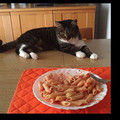的点评
Masterpiece of Romanesque architecture, also containing some works of universal value.
Duomo Di San Martino的点评
点评:The most accredited interpretations of art historians state that the Romanesque style of Lucca's architecture - which reached its highest expression in the city's Cathedral - owes much to Rainaldo, the attested author of the façade with columns of the Cathedral in nearby Pisa (first half of the 11th century). In Lucca, however, Rainaldo's style is grafted onto a peculiarity of local Romanesque architecture: extreme simplicity, which is inspired by ancient classical architecture (see also the splendid apse) but without pedantic imitations. Hence the lack - for example - of matroneums and domes.
In evaluating these stylistic elements, however, one should keep in mind that the original design of the Cathedral was altered by additions and transformations that continued until the end of the 14th century.
The personal interpretation of Rainaldo's decorative methods, in the case of the façade of the Lucca Cathedral, is due to the Lombard master Guidetto, who placed an atrium with powerful arches on the façade. The whole makes the architecture of this cathedral very original.
The outstanding character of this architecture is added to the excellence - for stylistic coherence - of some sculptures contemporary with the first construction phase of the church and inserted respectively in the portico and the facade: two lunettes, also by a Lombard artist, on the life of San Regolo (dispute with the Arians; beheading, mid-13th century) and the full-round statue - rare in the Romanesque period - of San Martino dividing his cloak with the poor man (the original is today inside the church).
Two other outstanding masterpieces can be visited in the church: the refined cenotaph (empty tomb) of Ilaria del Carretto (second wife of the lord of Lucca Paolo Guinigi, who died in childbirth), a work of the great Sienese sculptor Jacopo della Quercia (1406); and the “tempietto del Volto Santo”, a work by Matteo Civitali from Lucca (1484) which contains a venerated wooden crucifix of probably Syrian art (which is currently being restored).
Other masterpieces in the church should not be overlooked: sculptures, canvases, stained glass windows…. But even just the works already mentioned should ensure that a visit to Lucca without its cathedral is irremediably incomplete.
In evaluating these stylistic elements, however, one should keep in mind that the original design of the Cathedral was altered by additions and transformations that continued until the end of the 14th century.
The personal interpretation of Rainaldo's decorative methods, in the case of the façade of the Lucca Cathedral, is due to the Lombard master Guidetto, who placed an atrium with powerful arches on the façade. The whole makes the architecture of this cathedral very original.
The outstanding character of this architecture is added to the excellence - for stylistic coherence - of some sculptures contemporary with the first construction phase of the church and inserted respectively in the portico and the facade: two lunettes, also by a Lombard artist, on the life of San Regolo (dispute with the Arians; beheading, mid-13th century) and the full-round statue - rare in the Romanesque period - of San Martino dividing his cloak with the poor man (the original is today inside the church).
Two other outstanding masterpieces can be visited in the church: the refined cenotaph (empty tomb) of Ilaria del Carretto (second wife of the lord of Lucca Paolo Guinigi, who died in childbirth), a work of the great Sienese sculptor Jacopo della Quercia (1406); and the “tempietto del Volto Santo”, a work by Matteo Civitali from Lucca (1484) which contains a venerated wooden crucifix of probably Syrian art (which is currently being restored).
Other masterpieces in the church should not be overlooked: sculptures, canvases, stained glass windows…. But even just the works already mentioned should ensure that a visit to Lucca without its cathedral is irremediably incomplete.
翻译:艺术史学家最权威的解释是,卢卡建筑的罗马式风格(在该市的大教堂中达到了最高水平)很大程度上归功于雷纳尔多,他是附近比萨大教堂立面柱子的作者(11 世纪上半叶)。然而,在卢卡,雷纳尔多的风格被嫁接到当地罗马式建筑的一个特点上:极度简约,灵感来自古代古典建筑(参见华丽的后殿),但没有迂腐的模仿。因此,例如,没有主卧和圆顶。
然而,在评估这些风格元素时,应该记住,大教堂的原始设计因持续到 14 世纪末的增建和改造而发生了改变。
就卢卡大教堂的正面而言,伦巴第大师 Guidetto 对雷纳尔多的装饰方法进行了个人诠释,他在正面设置了一个带有强大拱门的中庭。整体使这座大教堂的建筑非常独特。
这座建筑的突出特点与教堂第一阶段建造时的一些雕塑的卓越性(风格连贯性)相得益彰,这些雕塑分别嵌入门廊和正面:两幅同样由伦巴第艺术家创作的半月形雕塑,描绘了圣雷戈洛的生平(与阿里乌斯派的争执;斩首,13 世纪中叶)和罗马式时期罕见的全圆形雕像——圣马蒂诺与穷人分披风(原件今天在教堂内)。
教堂内还有另外两件杰出的杰作可供参观:伊拉里亚·德尔·卡雷托(卢卡领主保罗·圭尼吉的第二任妻子,死于难产)的精致纪念碑(空墓),这是锡耶纳伟大的雕塑家雅各布·德拉·奎尔西亚 (Jacopo della Quercia) 的作品(1406 年);“圣沃尔托神庙”是卢卡的马泰奥·奇维塔利 (Matteo Civitali) 的作品(1484 年),里面有一个受人尊敬的木制十字架,可能是叙利亚艺术作品(目前正在修复)。
教堂内的其他杰作也不容错过:雕塑、油画、彩色玻璃窗……但即使只是上述作品,如果没有参观大教堂,卢卡之旅也将是不完整的。
然而,在评估这些风格元素时,应该记住,大教堂的原始设计因持续到 14 世纪末的增建和改造而发生了改变。
就卢卡大教堂的正面而言,伦巴第大师 Guidetto 对雷纳尔多的装饰方法进行了个人诠释,他在正面设置了一个带有强大拱门的中庭。整体使这座大教堂的建筑非常独特。
这座建筑的突出特点与教堂第一阶段建造时的一些雕塑的卓越性(风格连贯性)相得益彰,这些雕塑分别嵌入门廊和正面:两幅同样由伦巴第艺术家创作的半月形雕塑,描绘了圣雷戈洛的生平(与阿里乌斯派的争执;斩首,13 世纪中叶)和罗马式时期罕见的全圆形雕像——圣马蒂诺与穷人分披风(原件今天在教堂内)。
教堂内还有另外两件杰出的杰作可供参观:伊拉里亚·德尔·卡雷托(卢卡领主保罗·圭尼吉的第二任妻子,死于难产)的精致纪念碑(空墓),这是锡耶纳伟大的雕塑家雅各布·德拉·奎尔西亚 (Jacopo della Quercia) 的作品(1406 年);“圣沃尔托神庙”是卢卡的马泰奥·奇维塔利 (Matteo Civitali) 的作品(1484 年),里面有一个受人尊敬的木制十字架,可能是叙利亚艺术作品(目前正在修复)。
教堂内的其他杰作也不容错过:雕塑、油画、彩色玻璃窗……但即使只是上述作品,如果没有参观大教堂,卢卡之旅也将是不完整的。


此点评仅代表旅行者个人的主观意见,并不代表TripAdvisor以及其合作方的意见。
关于我们
|新闻动态
|商务合作
|会员中心
|业主中心
|常见问题
|意见反馈
|联系我们
|营业执照
© 2025 Tripadvisor 版权所有。
使用条款 |隐私政策 |网站工作原理
部分照片由 VFM Leonardo 提供。
* Tripadvisor不是旅行社,也不是旅游预订服务代理商。我们提供免费、客观、公正的旅游资讯服务。 (显示更多)
TripAdvisor LLC 既不是预订代理商,也不是旅游运营商,不会向网站用户收取任何服务费。 按照规定,在 Tripadvisor 发布机票价格、游览和旅行套餐的合作伙伴(航空公司、旅行提供商及预订代理商),其标价须包含所有费用和附加费用。 例如, 机场出入境税费、消费税与其他服务费、手续费、杂费及附加费用。 当您向我们的某个合作伙伴进行预订时,请务必查阅他们的网站以了解当地行政部门要求的所有适用费用的具体情况。 除非另有说明,机票价格通常指的是一个人的价格(以人民币计)。
为方便起见,TripAdvisor LLC 根据从我们的预订合作伙伴获取的空房率计算每个酒店的均价。 对于游览和景点来说,所显示价格通常是每位成人的最低可用价格。 对于列出的任何旅行套餐或优惠,TripAdvisor LLC 无法保证任何特定的费率或价格。 此外,酒店均价每晚会更新,并以您的首选币种表示(使用现行汇率)。 由于这些已换算的价格是预估价格,因此,有关具体金额和币种请与预订网站进行核实。
此外,TripAdvisor LLC 无法保证我们网站上宣传的价格随时有效。 标价可能需要预订一定天数才能生效,或有不可用日期、使用条件或限制。
TripAdvisor公司对外部网站的内容一概不负责。优惠价格中不含税和其他费用。
ICP证:沪B2-20200433
沪ICP备20013175号
 沪公网安备31010502005427号
沪公网安备31010502005427号鹰程信息技术(上海)有限公司
货币/国家及地区
¥CNY
中国

